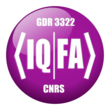| Main contact: | Serge Haroche |  |
| Other contacts: | Jean-Michel Raimond |  |
| Michel Brune |  | |
| Sébastien Gleyzes |  |
Research activities:
Quantum non-destructive observation of trapped photons, detection of field quantum jumps, reconstruction of non-classical field states and direct monitoring of decoherence (2006-2008)
Recently, the team has developed super-high finesse cavities which hold microwave photons over more than a tenth of a second. This has led to experiments in which trapped photon fields are manipulated and detected with unprecedented sensitivity and accuracy. The stored photons are continuously detected in a non-destructive way (Quantum Non-Demolition or QND method) by having them interact dispersively with atoms crossing one by one the cavity.
The progressive projection of the field into Fock states corresponding to definite photon numbers has been observed and the quantum jumps of a light field have been monitored in this way. For the first time, single photons are continuously observed in a box and the random times at which they are created or annihilated are directly recorded. The method, first applied to a single photon field, has been extended to fields made up of several photons, which are non-destructively counted in the cavity as if they were marbles in a box.
The quantum Zeno effect has been observed by the team on this system. It has shown that the coherent growth of the field when the cavity is coupled to a microwave source is frozen if the field is repeatedly watched by non-absorbing atoms.
Combining QND photon counting with a homodyne mixing method, the team has recently reconstructed the full quantum state of Fock and Schrödinger cat states of light whose classical components differ by up to 12 photons. By taking snapshots of these states at successive times, the team has realized actual movies of the decoherence process in progress, which clearly illustrate the transition from quantum to classical in a microscopic system coupled to an environment. Extension of these experiments to two cavities coupled by an atomic beam are in progress. They will make it possible to study the non-local properties of mesosocopic systems made of tens of photons or atoms.
These studies open the way to the investigation of quantum superposition and entanglement in mesoscopic systems of still larger sizes. The group has made many proposals to pursue the study of these systems as part of the exploration of the quantum classical boundary. In a related effort, it is also developping a new research atom-chip program aimed at the manipulation of ultra-cold Rydberg atoms in the vicinity of superconductors, with possible applications to high resolution spectroscopic surface studies and to quantum information.
For more information: see online Cavity QED




